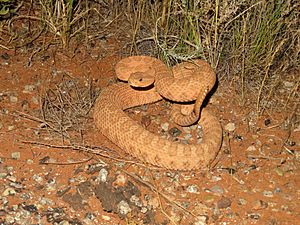Midget faded rattlesnake facts for kids
Quick facts for kids Midget faded rattlesnake |
|
|---|---|
 |
|
| Scientific classification | |
| Genus: |
Crotalus
|
| Species: |
concolor
|
| Synonyms | |
|
|
The Crotalus concolor is a type of venomous pit viper. This means it has fangs and can inject venom. It also has special heat-sensing pits on its face. You can find this snake in the western United States.
This snake is a small rattlesnake. It is known for its colors that look a bit faded. People also call it the midget faded rattlesnake, faded rattlesnake, or yellow rattlesnake.
Contents
Discovering the Faded Rattlesnake
This snake is a fascinating creature. It was first officially described in 1929 by a scientist named Angus M. Woodbury. He studied animals and plants in the western United States.
What Does the Faded Rattlesnake Look Like?
This snake is not very long. It can grow up to about 75 centimeters (about 2.5 feet). That's shorter than many other snakes.
The Crotalus concolor has a unique color pattern. Its main color can be pinkish, pale brown, yellow-brown, or even reddish. On top of this, it has brown blotches. These blotches are shaped like ovals or rectangles.
Many of these snakes are gray or silvery. When they are young, their patterns are very clear. But as they get older, the patterns start to fade. Sometimes, the pattern almost disappears into the snake's main color.
Where Do Faded Rattlesnakes Live?
You can find the Crotalus concolor in parts of the United States. They live in areas around the Colorado River and Green River.
This includes southwestern Wyoming and most of Utah. They also live in a small part of west-central Colorado. These snakes prefer dry, rocky areas.
Understanding Faded Rattlesnake Venom
The venom of the Crotalus concolor is very strong. It is one of the most potent venoms found in North America. In fact, studies show its venom can be much stronger than that of some Asiatic cobras.
This snake's venom contains a special substance. It is called concolor toxin. This toxin affects the nerves. The amount of this toxin can be different in each snake.
More About This Snake
If you want to learn more about this amazing snake, you can check out these books:
- Hubbs, Brian, and Brendan O'Connor. 2012. A Guide to the Rattlesnakes and other Venomous Serpents of the United States. Tricolor Books. Tempe, Arizona. 129 pp. ISBN: 978-0-9754641-3-7. (Crotalus oreganus concolor, pp. 32–33.)
- Woodbury, Angus M. 1929. A new rattlesnake from Utah. Bull. Univ. Utah 20 (1).
Images for kids


